Plan checklist
The Sjoholm Property
Island 2, 20 Stewart Lake Road, Stewart Lake
Planting plan created by The District Municipality of Muskoka
Funded by • Restore Your Muskoka Shore • Great Lakes Guardian Community Fund •


Schedule A:
Plants & Property
Land Characteristics
This planting plan is designed based on the land characteristics identified during the day of the site visit. Plants are chosen according to the soil and light conditions on your property. The number of plants chosen for each planting compartment takes into account the square metre area of the space, as well as the amount of current vegetation cover. Your property is part of ecoZone: 5a
Land Characteristics by Compartment
| Length | Width | Area | pH | Soil | Moisture | Light | Height | |
|---|---|---|---|---|---|---|---|---|
| A | 3m | 2.4m | 3.6m2 | acidic | loamy | dry, normal | full sun | |
| B | 3.7m | 1m | 3.7m2 | acidic | loamy | dry, normal | full sun | |
| C | 4.3m | 2m | 8.6m2 | acidic | loamy | dry, normal | full sun | |
| D | 1.5m | 3.7m | 5.6m2 | acidic | loamy | dry, normal | full sun, partial sun | |
| E | 2.4m | 2.6m | 6.2m2 | acidic | loamy | dry | full sun | |
| F | 2.7m | 1.8m | 4.9m2 | normal | loamy | dry, normal | full sun, partial sun | |
| 17.6m | 2.25m | 32.6m2 |
Plant Selection Summary
The following shrubs and trees are chosen for their suitability and survivability given the current soil and light conditions in each compartment on your property, as well as preferable features.
| Plant Species | A | B | C | D | E | F | Potted | Bareroot | Wildflower |
|---|---|---|---|---|---|---|---|---|---|
| Fragrant Sumac | 3 | 2 | 5 | ||||||
| Lowbush Blueberry | 3 | 2 | 5 | ||||||
| Wild Bergamot | 2 | 2 | 3 | 7 | |||||
| Wild Columbine | 6 | 3 | 9 | ||||||
| Eastern Red Cedar | 1 | 1 | 1 | 3 | |||||
| Allegheny Serviceberry | 2 | 3 | 5 | ||||||
| Common Juniper | 1 | 1 | |||||||
| Pearly Everlasting | 2 | 2 | |||||||
| Bush Honeysuckle | 3 | 2 | 5 | ||||||
| Smooth Blackberry | 2 | 2 | |||||||
| Purple Coneflower | 6 | 6 | |||||||
| Subtotal | 14 | 3 | 7 | 9 | 11 | 6 | 26 | 0 | 24 |
| Totals | 50 | ||||||||
Plant Information
The following table summarizes key information about each plant selected for your property.
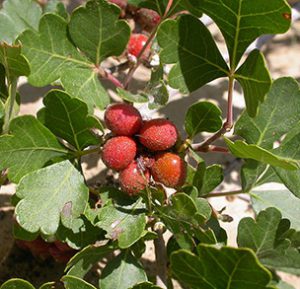
|
Fragrant SumacHeight: 1-2m
The Fragrant Sumac is a medium-sized deciduous shrub within the Cashew family. This species grows between 1-2 meters in height, is multi-stemmed, and produces a round, dense crown composed of erect and spreading branches. Between March and April, small yellow flower clusters bloom on the terminal ends of the branches prior to leaf development. Fruit development begins during late summer. Small, red, hairy berries are produced and can remain on the plant throughout the winter. Male catkins develop on the plant in September. Fragrant Sumac leaves are simple and arranged alternately along the branch. Leaves produced are simple and trifoliate with a large center lobe, appearing similar to Poison Ivy. During the spring and summer, the leaves are light green to green-yellow in colour turning a bright yellow to red or dark purple in autumn. Crushed leaves and stems of the Fragrant Sumac produce a fragrant citrus aroma, hence the common name. The aroma of this shrub is attractive to butterfly species, making it the perfect addition to any butterfly garden. The roots of the Fragrant Sumac are shallow, fibrous, and spread rapidly, making it an ideal choice for stabilizing shorelines and mitigating erosion on steep slopes. Unlike other Sumac species, Fragrant Sumac is significantly less aggressive and easily maintained.
|
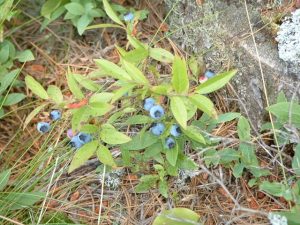
|
Lowbush BlueberryHeight: 60 cm
The Lowbush Blueberry is a low growing, deciduous shrub that only reaches about 60 cm in height. This species grows erect, with many spreading and ascending branches. New branch growth is soft and green-brown in colour, while older branches are woody and have shredded looking bark. The leaves are small, simple leaves alternately arranged, and have finely serrated margins. During the fall, this shrub's lustrous blue-green leaves turn into an electrifying bronze, scarlet or crimson colour. Clusters of small, white, bell-shaped flowers bloom between May and June. By July, the flowers give way to clusters of edible blueberries. These berries provide a significant food source for a variety of bird and mammal species.
|
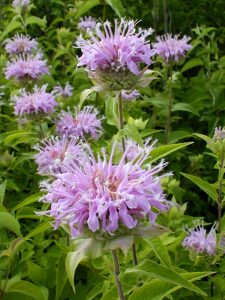
|
Wild BergamotHeight: 1 m
Wild Bergamot is a perennial wildflower species that is member of the mint family and can grow about 1 m tall. Its stems are light green and smooth with abundant branching on the upper half. The leaves are oppositely arranged, broadly lanceolate shaped, 6-10 cm long, and have toothed edges. The also leaves emit a aromatic minty/oregano scent when crushed. The flowers are showy, pink/lavender coloured, appear on the ends of flowering stems, and bloom between July and September. The flowers bloom in the center of the head first, moving outwards creating a wreath. The flowers are beneficial to pollinator species, like bees and butterflies. This wildflower spreads well and can be used to naturalize un-vegetated areas. The roots can be useful for controlling erosion and stabilizing shorelines.
|
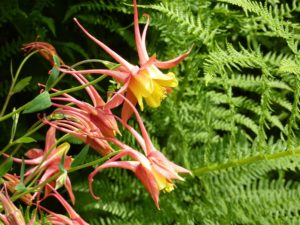
|
Wild ColumbineHeight: 0.5 m
Wild Columbine is a perennial wildflower that grows about 0.5 m tall and is popular among gardeners due to its beautiful red and yellow coloured flowers. These flowers are nodding flowers, meaning that they droop downwards off the end of the branch. They have five sepals and five petals that stretch upwards creating five long spurs out the back. The leaves are attractive, compound and made up of 9-27 leaflets, appear in groups of three, and are rounded or broadly egg-shaped with rounded lobes. The sweet nectar of this wildflower is a great attractant to hummingbirds and butterflies.
|
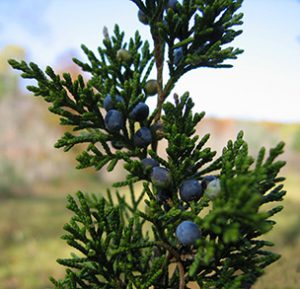
|
Eastern Red CedarHeight: 10-15m
The Eastern Red Cedar is a medium-large sized tree species which produces scale-like evergreen leaves on mature trees that grow to 10-15m. The leaves are needles and are blue-green colored, paired, and grow tight to the twig. This tree's twigs are light green to reddish-brown, slender, and four-sided. Eastern Red Cedar is a dioecious species with separate male and female trees. Male trees produce yellow cones that are 3 mm long, while females produce berry-like cones that are 3-6 mm round, deep blue, and covered in a whitish powder. These berry-like fruits ripen at the beginning of autumn, and are a valuable food source for birds and small mammals. The Eastern Red Cedar produces a single trunk covered in bark, which is brown-grey and exfoliates into strips. This species is branched near the base, produces a conical to cylindrical crown, and has a root system that is fibrous and moderately deep. This tree species is long lived and can reach 150-350 years old.
|
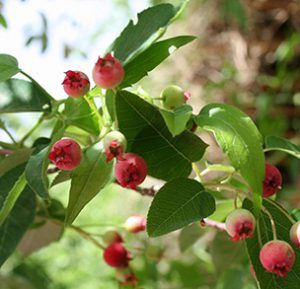
|
Allegheny ServiceberryHeight: 3-10 m
The Allegheny Serviceberry is an attractive deciduous shrub species that can reach about 3 m as a shrub or up to 10 m as a tree. This plant may also be known by the common name Smooth Serviceberry. It can be grown either in the form of a single stem tree or multi-stemmed shrub comprised of two or three smaller trunks. The leaves are dark green, alternately arranged, oval shaped, and have finely toothed margins. The flowers are showy, fragrant, have 5 petals, appear in drooping clusters, and bloom in April before the leaves emerge. The flowers produce small reddish purple to black berries, which are edible and flavorful to humans. The fruit is beneficial to wildlife species, including birds and small mammals. The root system is valuable for controlling erosion and stabilizing loose soil. This plant is often used for ornamental purposes as a small tree in urban areas.
|
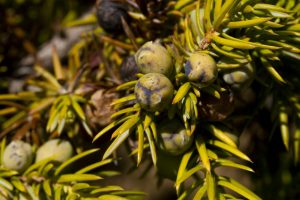
|
Common JuniperHeight: 1 m
The Common Juniper is a small, low spreading coniferous shrub with stiff branches which typically grows 1m in height. This species can occasionally grow upright in favorable conditions. The Common Juniper is found across North America as well as Greenland, Europe, Siberia, and Asia. This species grows green needles with sharp tips found in whorls of 3 on branches. The seed cones of this plant resemble berries and grow along mature branches. The seed cones of Common Juniper begin green and take eighteen months to ripen, turning a dark purple or black colour and developing a blue wax coating.
|
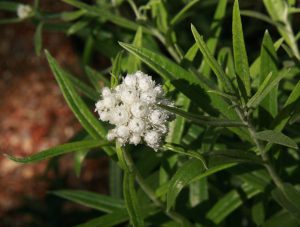
|
Pearly EverlastingHeight: 1m
Pearly Everlasting is a medium sized wildflower species which grows up to 1 m in height. The leaves are grey-green, long and narrow, simple, and alternately arranged. The flowers are small, white colored with yellow centers, have silvery hue appearance, appear in attractive clusters, and bloom between July and August. It is also a great attractant for the American Lady Butterfly because it is a host for its larvae. Historically, Pearly Everlasting was used as a salve to treat burns, bruises, swelling, and joint pain.
|
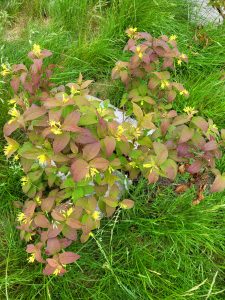
|
Bush HoneysuckleHeight: 1m
The Bush Honeysuckle is a small, hardy, deciduous shrub that rarely grows taller than 1 m in height. The leaves are simple, oppositely arranged, ovate shaped, and have finely toothed margins. During the spring and summer, the leaves are dark green in colour, then in the fall they take on a variety of colours ranging from a deep purple to light yellow. The flowers are small, showy, yellow to orange colored, trumpet shaped, appear in clusters on the tips of branches, and bloom between June and July. The flowers are beneficial to pollinator species, including hummingbirds and butterflies. The roots of the Bush Honeysuckle are fibrous, giving it the ability to form thickets and making it an ideal shrub to plant for erosion control.
|
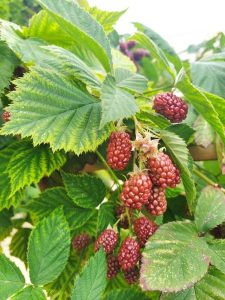
|
Smooth BlackberryHeight: 2m
The Smooth Blackberry, also referred to as Canadian Blackberry, Thornless Blackberry and Smooth Highbush Blackberry, is a medium sized shrub species and member of the Rose family, that reaches heights of 2m. This species forms irregular thickets with reddish-purple to brown stems. Leaves produced are lance-shaped, arranged alternately along the branches and are compounded with five leaflets. During the fall, the leaves turn from light green to dark red or deep purple. During the spring and summer, five-petaled, white flowers grow in clusters of up to 25 at the end of the branches. By mid-summer, the flowers give rise to edible purplish-black fleshy fruits, which ripen by late August. The fruiting bodies of this shrub provide an important abundant food source for many birds and mammal species. This shrub is good for controlling erosion and stabilizing shorelines.
|
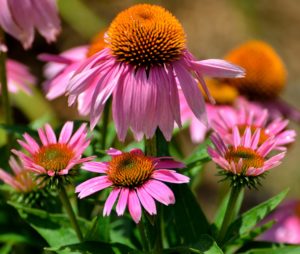
|
Purple ConeflowerHeight: 1m
Purple Coneflower is a perennial wildflower that typically grows about 1 m tall. This plant may also be known by the common name Echinacea. The leaves are dark green coloured, alternately arranged, lance shaped with pointed tips, and have serrated margins. The flowers are showy, pale purple to pink, have 15-20 toothed petals, appear atop erect stems, and bloom between June and August. This wildflower spreads well and can be used to naturalize un-vegetated areas. The roots can be useful for controlling erosion and stabilizing shorelines. This flower blooms for long periods. The flowers are beneficial to pollinator species, like bees and butterflies. The seeds are also beneficial to wildlife species, like birds and small mammals.
|
Compartment A
Naturalization Area
Beaver & deer concerns pH: acidic
pH: acidic Depth: wildflowers
Depth: wildflowers-
 Moisture: dry, normal
Moisture: dry, normal -
 Soil Type: loamy
Soil Type: loamy -
 Light conditions: full sun
Light conditions: full sun
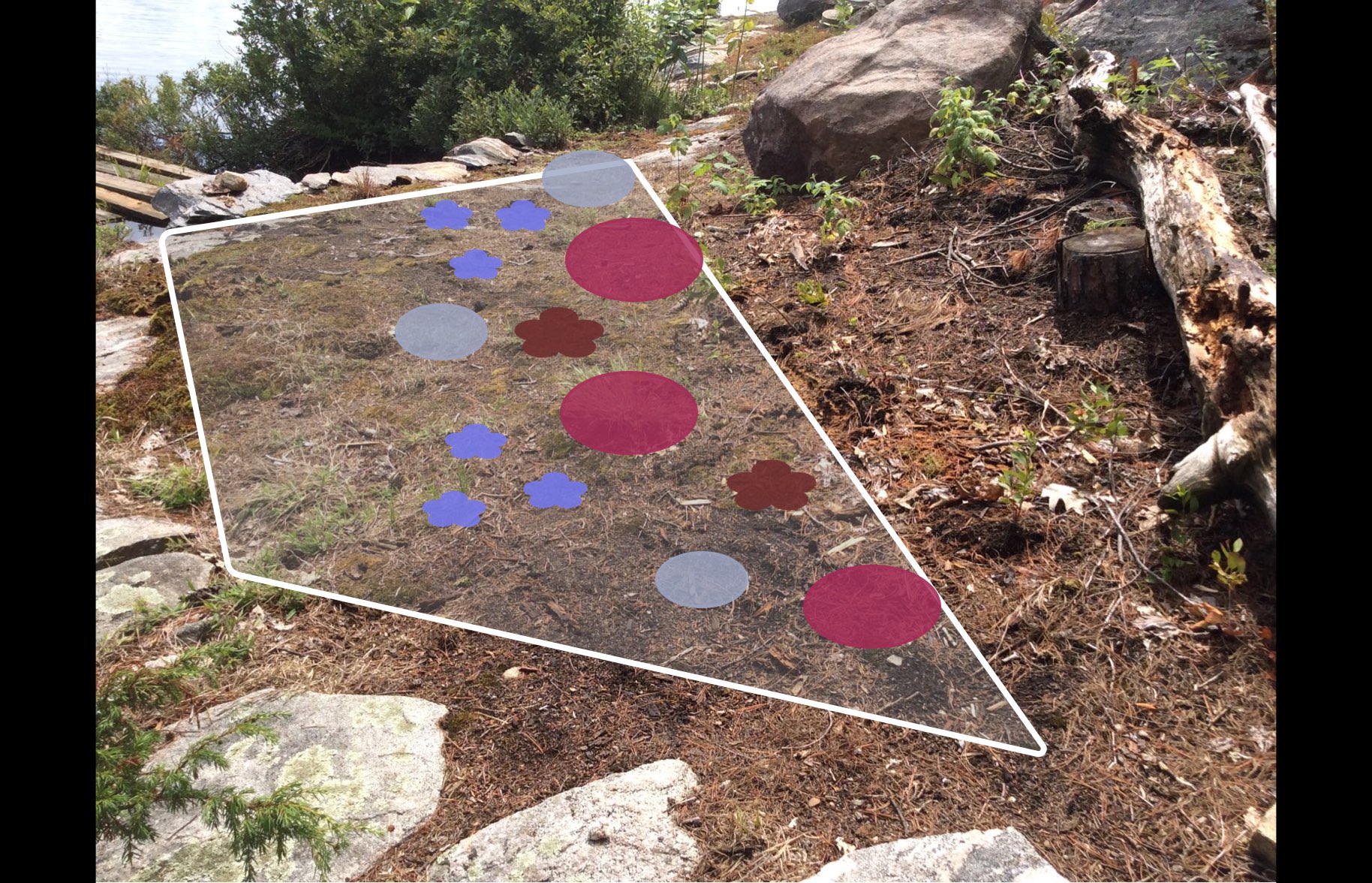
Compartment B
Naturalization Area
 pH: acidic
pH: acidic Depth: potted
Depth: potted-
 Moisture: dry, normal
Moisture: dry, normal -
 Soil Type: loamy
Soil Type: loamy -
 Light conditions: full sun
Light conditions: full sun
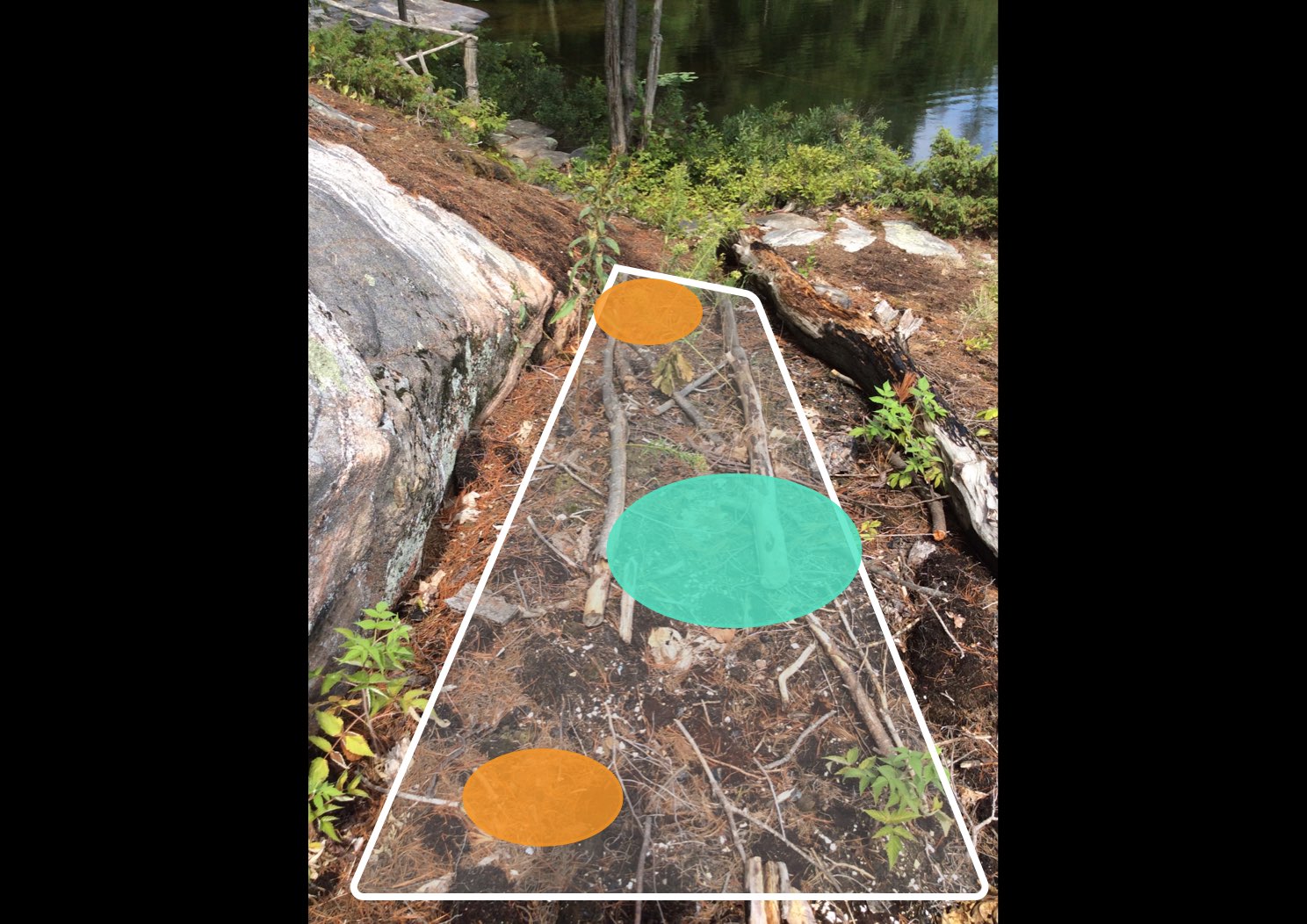
Compartment C
Naturalization Area
 pH: acidic
pH: acidic Depth: potted
Depth: potted-
 Moisture: dry, normal
Moisture: dry, normal -
 Soil Type: loamy
Soil Type: loamy -
 Light conditions: full sun
Light conditions: full sun
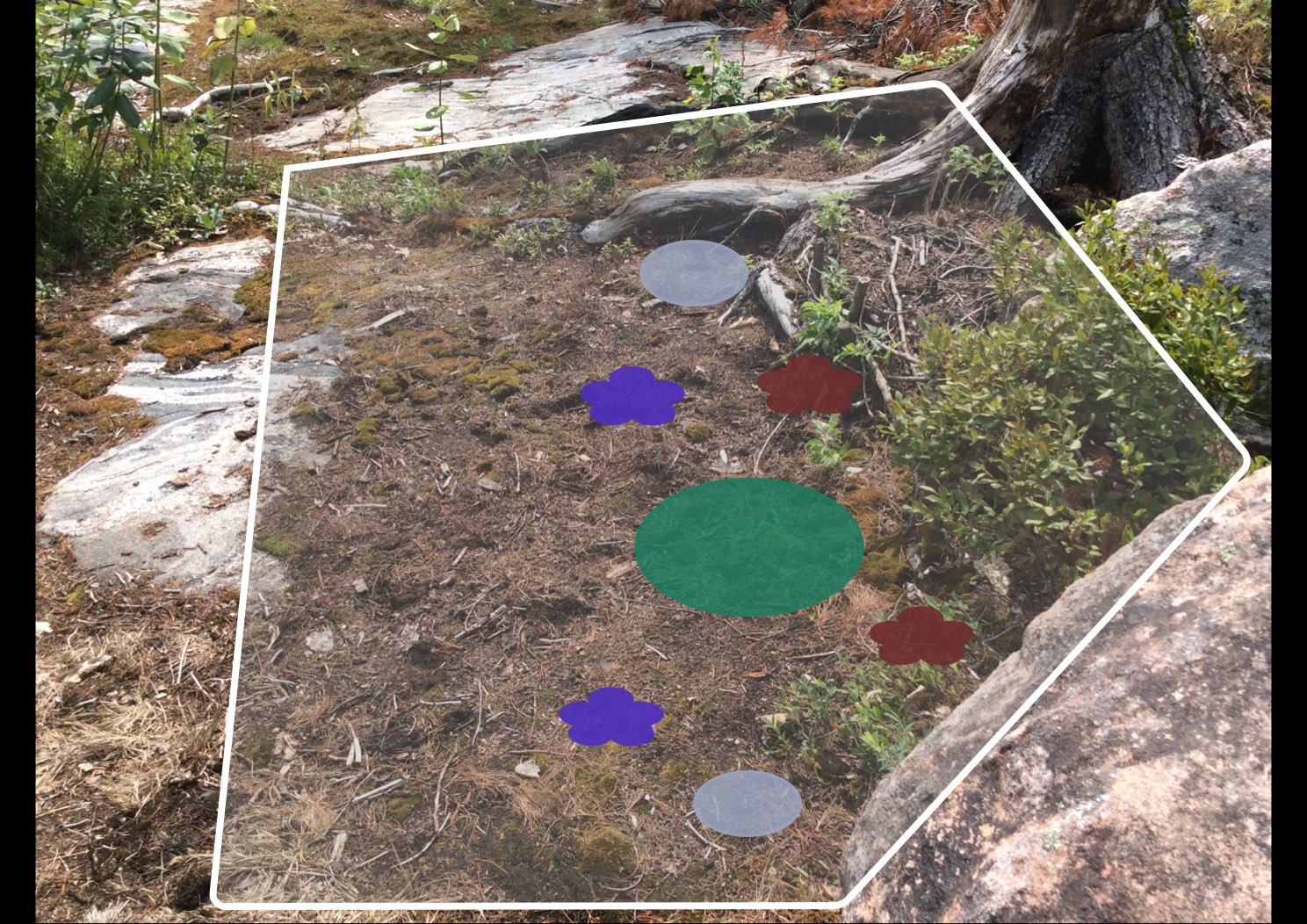
Compartment D
Naturalization Area
 pH: acidic
pH: acidic Depth: potted
Depth: potted-
 Moisture: dry, normal
Moisture: dry, normal -
 Soil Type: loamy
Soil Type: loamy -
 Light conditions: full sun, partial sun
Light conditions: full sun, partial sun
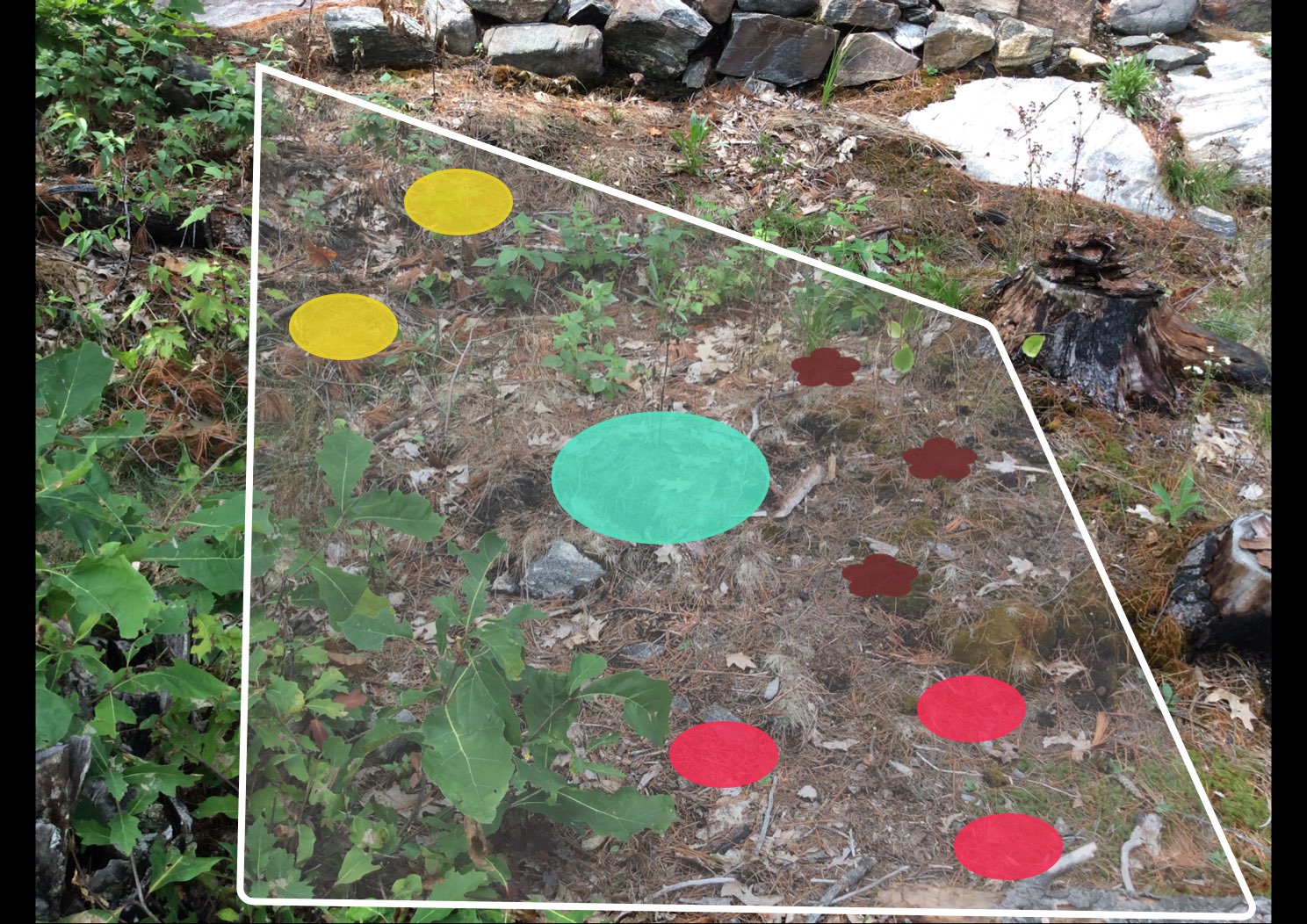
Compartment E
Naturalization Area
 pH: acidic
pH: acidic Depth: wildflowers
Depth: wildflowers-
 Moisture: dry
Moisture: dry -
 Soil Type: loamy
Soil Type: loamy -
 Light conditions: full sun
Light conditions: full sun
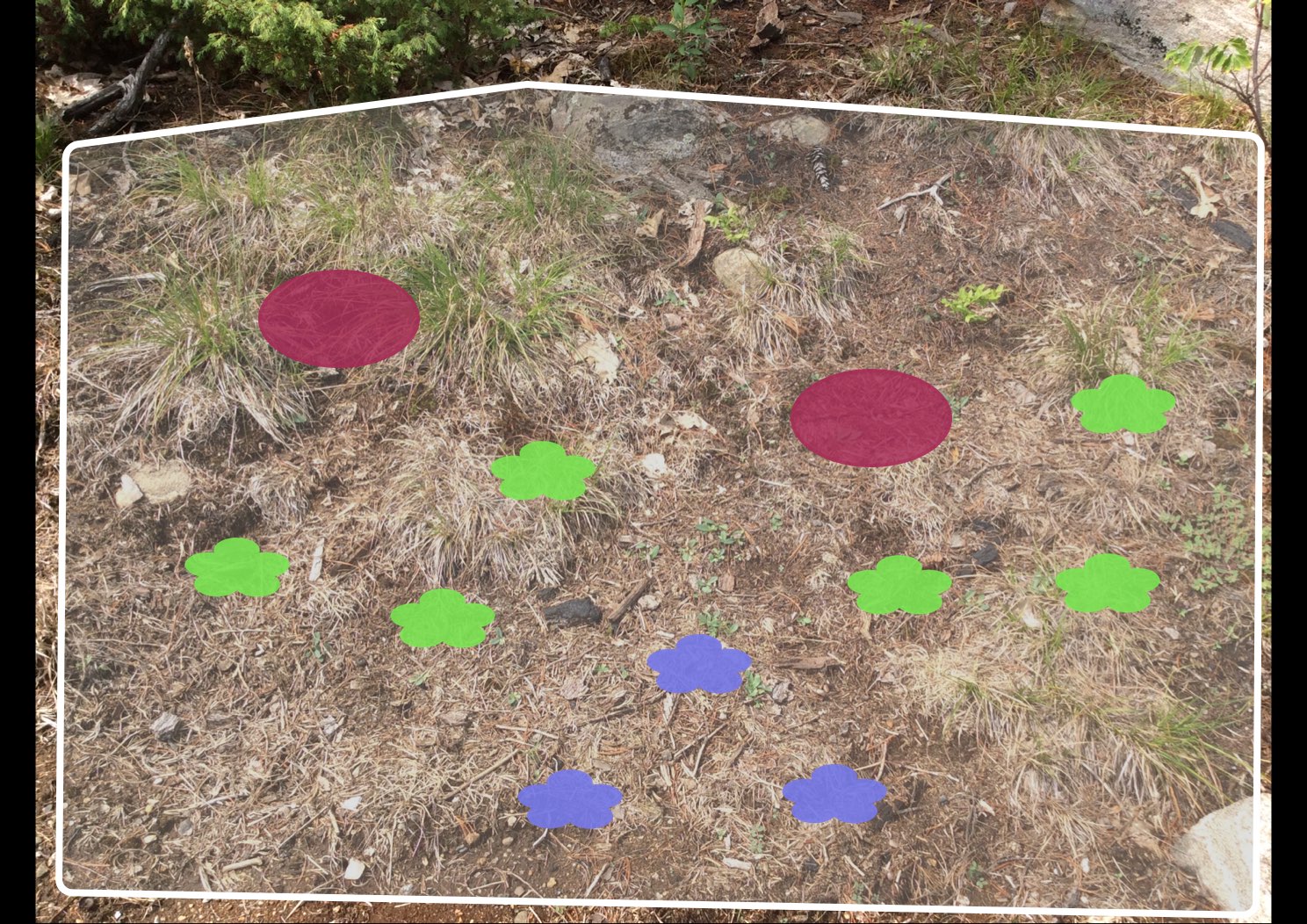
Compartment F
Naturalization Area
 pH: normal
pH: normal Depth: potted
Depth: potted-
 Moisture: dry, normal
Moisture: dry, normal -
 Soil Type: loamy
Soil Type: loamy -
 Light conditions: full sun, partial sun
Light conditions: full sun, partial sun
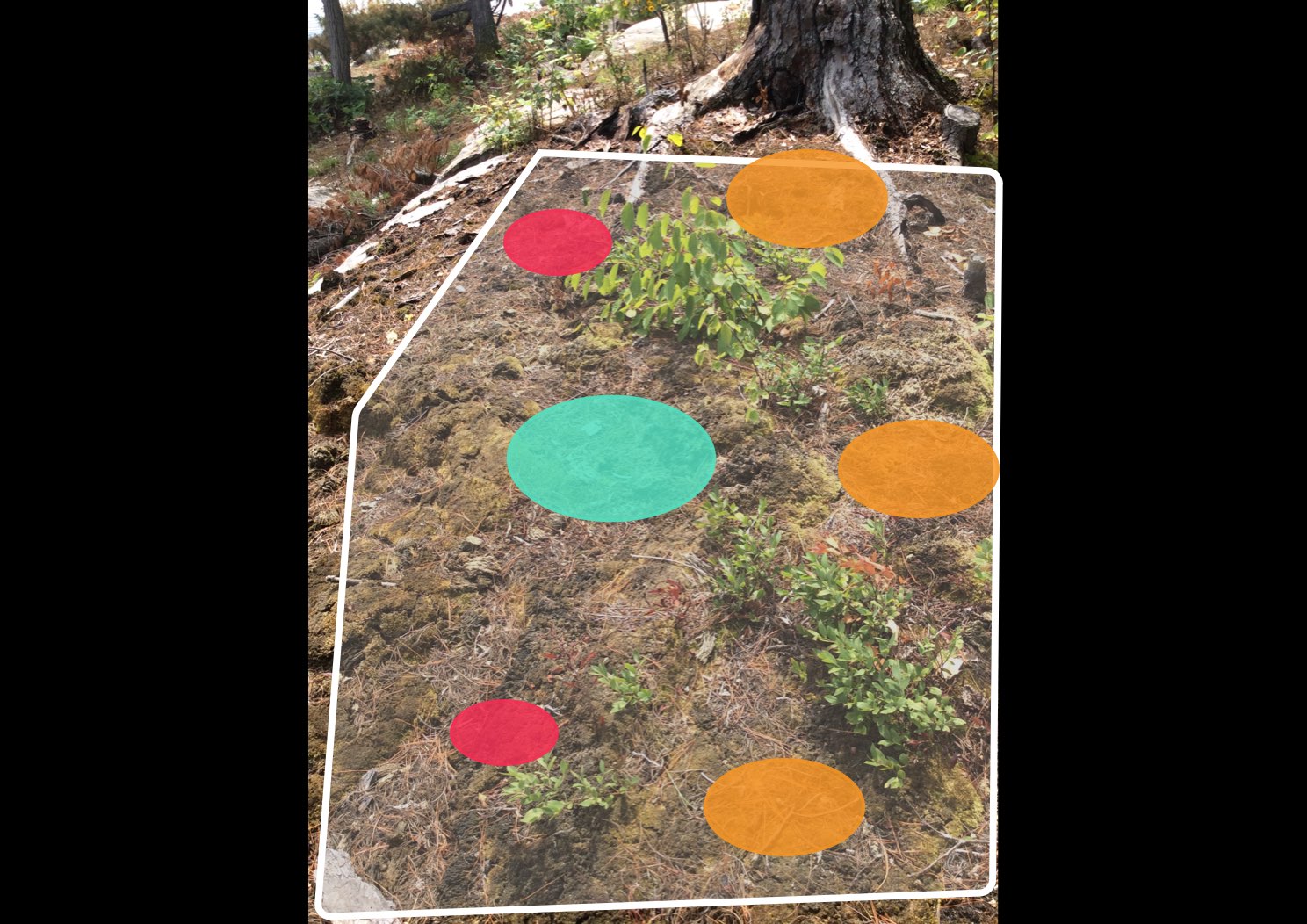
Schedule B
Financial Summary
Project by: The District Municipality of Muskoka
Shoreline Re-Naturalization Starter Kit includes: free site visit, customized re-naturalization planting plan for your shoreline property, native plants including free bare root (small) and potted (large) plants and wildflowers, coconut fibre pads to deter grass from growing around new plantings, tree guards for all deciduous trees, mulch for your wildflowers, Plant Care Guide with instructions on how to take care of your new plants, Habitat Creation Guide and a Wildflower Garden Guide.
Our planting plans are created onsite with you and provide detailed information and plans to re-naturalize your shoreline property. We take photos of areas for planting and overlay native plants that are well suited to your property based on site conditions such as soil type and sunlight availability.
We will work with you to create a plan that works for you including options for low growing plants in areas where views are important.
| Item | Quantity | Cost/Item | Subtotal |
|---|---|---|---|
| Starter Kit fee | $300 | ||
| Free potted plants | 20 | $0 | $0 |
| Paid potted plants | 6 | 12.00 | 72.00 |
| Free bareroot plants | 0 | $0 | $0 |
| Free wildflowers | 24 | $0 | $0 |
| Total costs | 372.00 |
Schedule C
Project Agreement
Stewardship Agreement
Please indicate your agreement to this proposed plan by signing the following Stewardship Agreement and submitting it, along with your financial contribution, to:
The District Municipality of Muskoka
70 Pine Street
Bracebridge, Ontario
P1L 1N3
Plant Availability
Please note that plant species may need to be changed based on plant stock availability at the time of ordering.
Project Completion
Upon receiving your signed stewardship agreement and financial contribution, a date will be booked for you to pick up your Natural Edge Kit. The District Municipality of Muskoka will supply all plants and materials. If you are paying for the planting to be completed for you, a date will be arranged for The District Municipality of Muskoka to plant your shoreline, bringing the plants and materials with them. If there are particular dates that you would prefer, we will do our best to accommodate your requests.
The Natural Edge Stewardship Agreement with The District Municipality of Muskoka
Agreement made this Day of the Month of in the Year .
BETWEEN Scott Sjoholm Island 2, 20 Stewart Lake Road MacTier Ontario (Hereinafter called the OWNERS)
AND The District Municipality of Muskoka 70 Pine Street Bracebridge, Ontario P1L 1N3 (Hereinafter called DMM)
WHEREAS the Owners and DMM have met and discussed plans for shoreline naturalization on the specified area(s) in Schedule A existing on the Owners’ land;
WHEREAS the Owners indicate approval of the project as proposed; and
WHEREAS the project is, or will be for the benefit of the Owners and others;
NOW THEREFORE THE PARTIES AGREE AS FOLLOWS:
1. This Agreement shall be in effect for a period of 5 years, commencing with the date of this Agreement.
2. The Owners and DMM agree that the areas where the work is to be performed is as described in Schedule A.
3. The Owners agree to pick up their Natural Edge Starter Kit from DMM’s office and plant their shoreline within two days of receipt. The Owners will provide “after” photos of the work completed to be used for reporting purposes. If the Owners wish to have the planting completed for them, then DMM or it’s contractors, employees and agents will complete the planting at cost, as indicated in Schedule B.
4. If the planting is to be completed by DMM, then the Owners grant DMM, its contractors, employees and agents, the right to enter the property to perform the work agreed upon as outlined in Schedule A. In addition, DMM, its contractors, employees and agents may inspect the work performed for the purposes of monitoring the project and survival assessment, with prior agreement with Owners for date and time of inspection.
5. The Owners agree to contribute the “Landowner contribution” and pay the costs indicated in Schedule B.
6. In instances where the Owners are to pay DMM for work to be performed (outlined in Schedule A), the Owners agree to provide payments to DMM prior to the commencement of that operation. Failure of payment shall constitute a breach of this Agreement and the Owners agree that this Agreement will be terminated and thereupon the Owners agree to pay DMM the estimated costs of the operations of the project completed to date, if any.
7. The Owners agree, if necessary, to perform a reasonable amount of maintenance, which is described in the Native Plant Care Guide, available at naturaledge.watersheds.ca.
8. If a contractor is required to perform the work outlined in Schedule A, then the contractor carrying out the work on the land described will be required to take out and furnish evidence of a comprehensive policy of public liability and property damage coverage. The contractor and their workers will be required to be in good standing with the Workplace Safety and Insurance Board (WSIB) prior to performing the work.
9. The Owners agree not to remove, destroy or alter the project without prior consultation and approval of DMM. Pruning and trimming planted nursery stock, or adding replacement native nursery stock is exempt.
10. The Owners agree not to mow the planted area.
11. The Owners do acknowledge that DMM, its contractors, employees and agents, having performed said works, are not under further obligation with respect to survival of nursery stock, inspection, or maintenance.
12. The Owners, in the absence of negligence, hereby remise, release and forever discharge DMM, its contractors, employees and agents from all claims and demands for injuries, including death, loss, damages and costs in any way related to or connected with installation and maintenance of the work described or resulting from any deleterious effects of the work to the land or to the lands and buildings thereon retained by the Owners.
IN WITNESS WHEREOF the parties have agreed to the contents of this plan; SIGNED:
About this program
About The District Municipality of Muskoka
The District of Muskoka is an upper-tier municipality that has monitored water quality in Muskoka area lakes since 1980. Since 2002, the Muskoka Water Strategy has provided integrated and strategic initiatives for the protection of Muskoka's water resources. The purpose of the strategy is to guide and minimize the impact of human activities on water resources; ensure human and environmental health; and preserve the quality of life in Muskoka.
This program was created by Watersheds Canada
We believe that every person has the right to access clean and healthy lakes and rivers in Canada. At Watersheds Canada, we work to keep these precious places naturally clean and healthy for people and wildlife to continue using for years to come. We love working with others to meet the needs of local communities, whether you’re a concerned citizen, a landowner, a lake association looking for help, or a coalition of groups interested in activating your local community.

